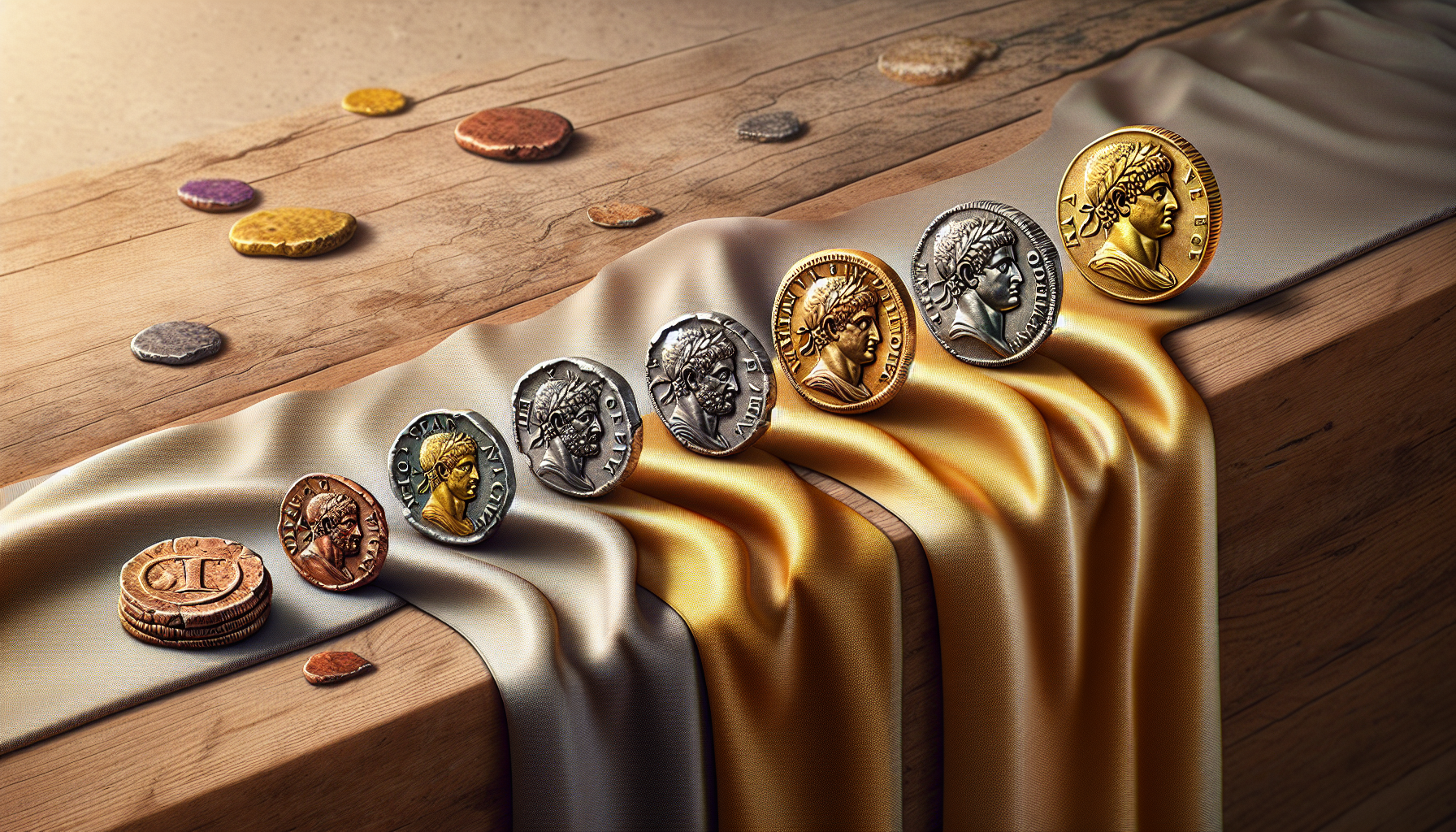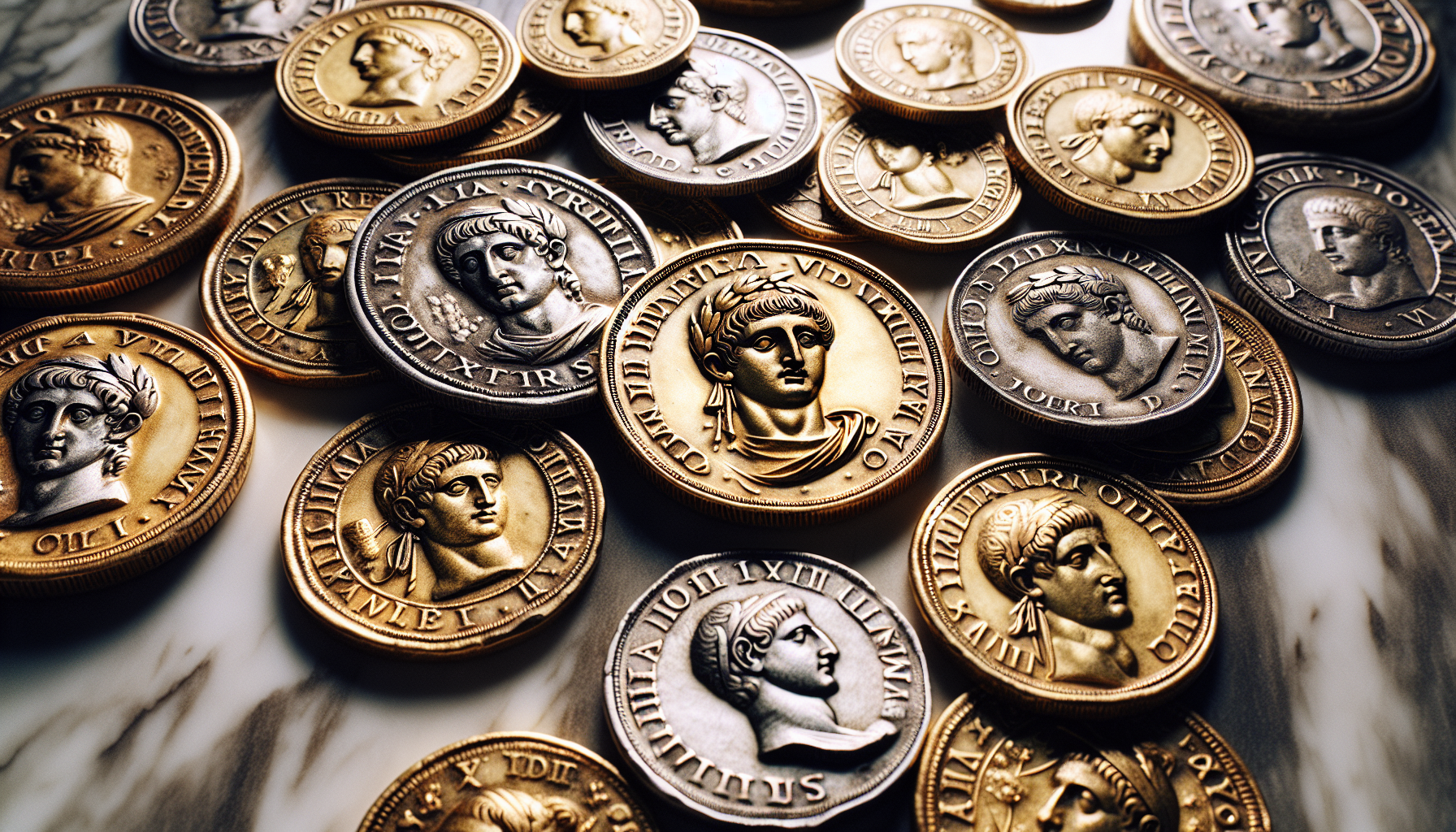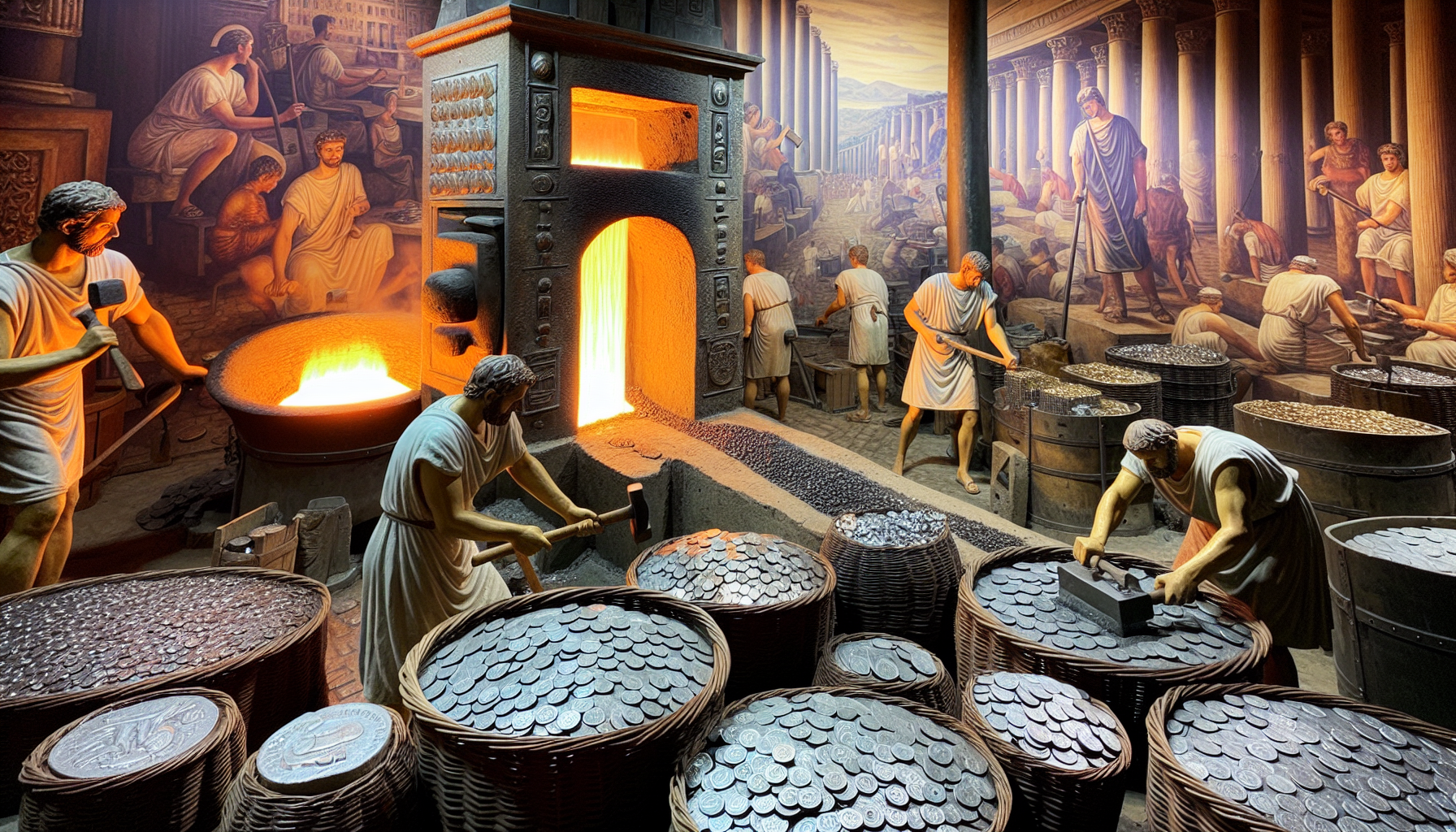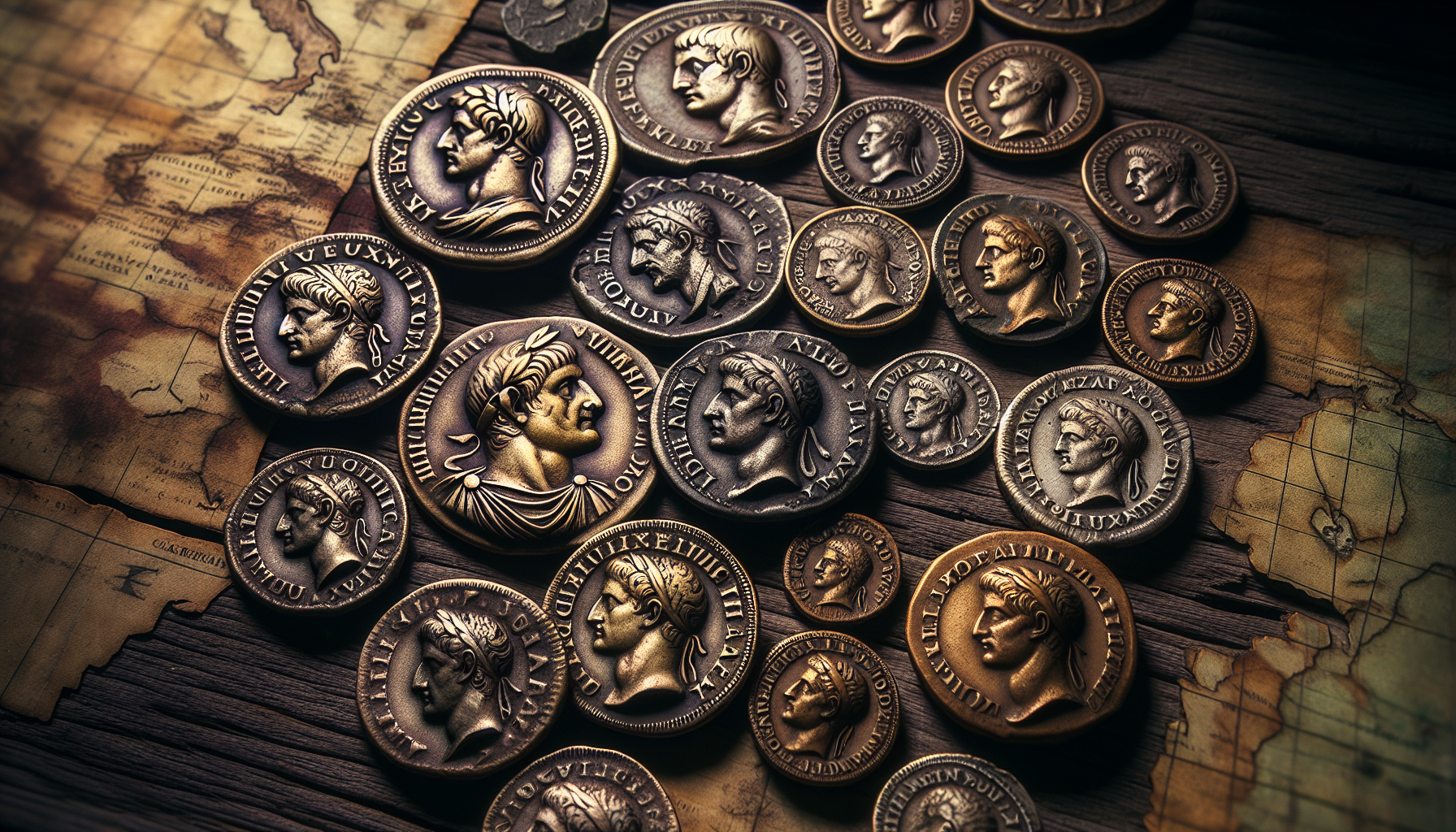The ancient Romans were a people of many innovations, and their currency system was no exception. From the aes rude to the gold aureus, Roman coins were not just a medium of exchange but a canvas for propaganda, a time capsule of history, and a fascinating reflection of the socio-economic dynamics of the time. This journey into the world of Roman currency promises to be as enlightening as it is engaging.
Key Takeaways
- Roman currency evolved over time, from the aes rude to silver denarius and gold coins like the aureus and solidus.
- Coins featured iconic imagery conveying political power, religious authority, portraits of emperors & families as well as mythological figures & divine associations.
- The debasement of Roman currency caused economic crisis. Collecting ancient coins is an educational endeavor with reputable dealers for authentication & grading services available.
Evolution of Roman Currency

The evolution of Roman currency is a journey through time that mirrors the rise and expansion of the Roman Empire itself. The transition from the basic aes rude to the more uniform aes grave indicated the emergence of a coinage system that would last for centuries.
This evolution was not just a matter of convenience or trade; it was a reflection of the socio-economic and political dynamics of the time.
Aes Rude and Aes Grave
The aes rude, raw pieces of bronze, symbolized the first form of currency in Rome. These were supplanted by the aes grave, substantial cast bronze coins that marked the advent of the first standardized Roman coinage system, known as bronze coinage, around 300 BCE.
The aes grave’s distinct weight and form, achieved through casting in clay moulds, ensured the coin’s authenticity and established a reliable medium of exchange.
Introduction of Silver Denarius
The introduction of the silver denarius around 211 BCE marked a pivotal point in the history of Roman currency. The denarius became the primary silver coin of Rome, underscoring its substantial significance and predominant role as a medium of exchange and economic standard.
The denarius, with a weight of around 4.5 grams, equalled 10 bronze asses, making larger transactions manageable and trade more straightforward.
Gold Aureus and Solidus
The need for a standardized and valuable gold coin led to the introduction of the gold aureus. Here are some key features of the aureus:
- Weight: approximately 8.00 grams
- Gold content: around 24 Greco-Roman carats
- Primary gold currency in the Roman Empire from the 1st century BC to the early 4th century AD.
Emperor Constantine I launched the gold solidus in 312 CE, creating a more dependable and lasting currency benchmark.
Iconography and Significance on Roman Coins

Roman coins had a twofold function: acting as a means of exchange and a tool for propaganda. The portraits of emperors, mythological figures, and commemorations of significant events etched on these coins were more than mere decorative elements; they were symbols of power, divine association, and historical record.
Portraits of Emperors and Their Families
The practice of engraving the portraits of Roman emperors on Roman coins was a powerful tool of propaganda, immortalizing them in precious metal and documenting their appearance and victories. The obverse side commonly featured a profile portrait of the reigning Roman emperor, often adorned with a radiant crown or laurel leaves.
Occasionally, members of the imperial family were also portrayed on gold coins and silver coins, further enhancing the symbolic power of these coins.
Mythological Figures and Divine Associations

The depiction of mythological characters and divine connections on Roman coins emphasized the emperor’s divine standing and linked him with the revered pantheon of gods. Gods and goddesses such as:
- Jupiter
- Mars
- Venus
- Minerva
were frequently depicted, each symbolizing a distinct aspect of life and power in the Roman worldview.
Commemorative Coins and Architectural Achievements
Roman coins also served as commemorative pieces, signifying significant events, architectural accomplishments, and displaying the magnificence of the Roman Empire. These coins celebrated emperors, documented the expansion of the empire, and even showcased renowned monuments such as temples, arches, and ports.
Notable Mints and Coin Production

The production of Roman coins was a meticulous process carried out in mints located throughout the empire. Rome, as the heart of the empire, functioned as the main mint, issuing a wide range of coins for circulation. Other significant mints were located in regions as diverse as:
- Barcelona
- Colchester
- Bitterne
- Istanbul
Each contributing to the vast array of Roman coins, including a single roman coin, ancient coins, and those from the Roman Republic era.
Debasement and Crisis in Roman Currency
The degradation of Roman currency was a complex problem that originated from fiscal strains on the empire. The continuous minting of coins, due to taxation covering only 80% of the imperial budget, led to an overproduction of coins, reducing their metal content and value.
This debasement of currency led to economic instability and distrust among the general population, impacting the entire Roman economy.
Collecting Ancient Roman Coins
Collecting ancient Roman coins transcends a hobby; it’s a passage into Roman history, culture, and economics. From the Twelve Caesars collection to identifying authentic coins and finding reputable dealers, each aspect of coin collecting offers a unique insight into the world of ancient Rome.
The Twelve Caesars Collection

The Twelve Caesars collection holds a special place in the world of numismatics. Consisting of coins from each of the rulers from Julius Caesar to Domitian, this collection offers a unique insight into the lives and reigns of these influential figures who played a pivotal role in shaping the Roman Empire.
Tips for Identifying Authentic Coins
Recognizing genuine Roman coins demands sharp observation skills and a solid grasp of Roman coinage. From the materials used to inscriptions and imagery, each element provides clues to the coin’s authenticity. Knowing how to spot inconsistencies such as abnormal wear patterns or additional metal can help distinguish a counterfeit coin.
Reputable Dealers and Grading Services
Locating trustworthy dealers and grading services is a key step in the collection of ancient Roman coins. Dealers such as Civitas Galleries, Ancient Imports, and Dirty Old Coins are known for their authenticity and customer service.
Grading services such as NGC and PCGS provide expert evaluation to determine a coin’s authenticity and quality, establishing a benchmark for their value in the collectors’ market.
Summary
The world of Roman currency is a fascinating journey through time, mirroring the rise and expansion of the Roman Empire itself. From the primitive aes rude to the esteemed gold aureus, each coin tells a story of power, propaganda, and socio-economic dynamics. As we explore the iconography on these coins, delve into the process of their production, and navigate the world of coin collecting, we gain a deeper understanding of the intricate tapestry that is Roman history.
Frequently Asked Questions
What is Roman currency called?
Roman currency was called denarius and aureus, with the latter being the gold monetary unit equal to 25 silver denarii.
What coin did the Roman use?
The most popular and prevalent coin used by the Romans was the denarius, a pressed silver coin that remained in circulation for over five centuries.
Did the Roman Empire have one currency?
The Roman Empire did not have a single unified currency initially, as it was comprised of three separate money systems. However, these were later rationalised into a single unified system.
Why were the portraits of emperors engraved on Roman coins?
Engraving the portraits of emperors on Roman coins was a form of propaganda, symbolizing their power and authority over the citizens.
What is the significance of the Twelve Caesars collection?
The Twelve Caesars collection is an invaluable resource that offers a detailed look into the lives and rule of the first twelve Roman emperors, beginning with Julius Caesar and concluding with Domitian.
